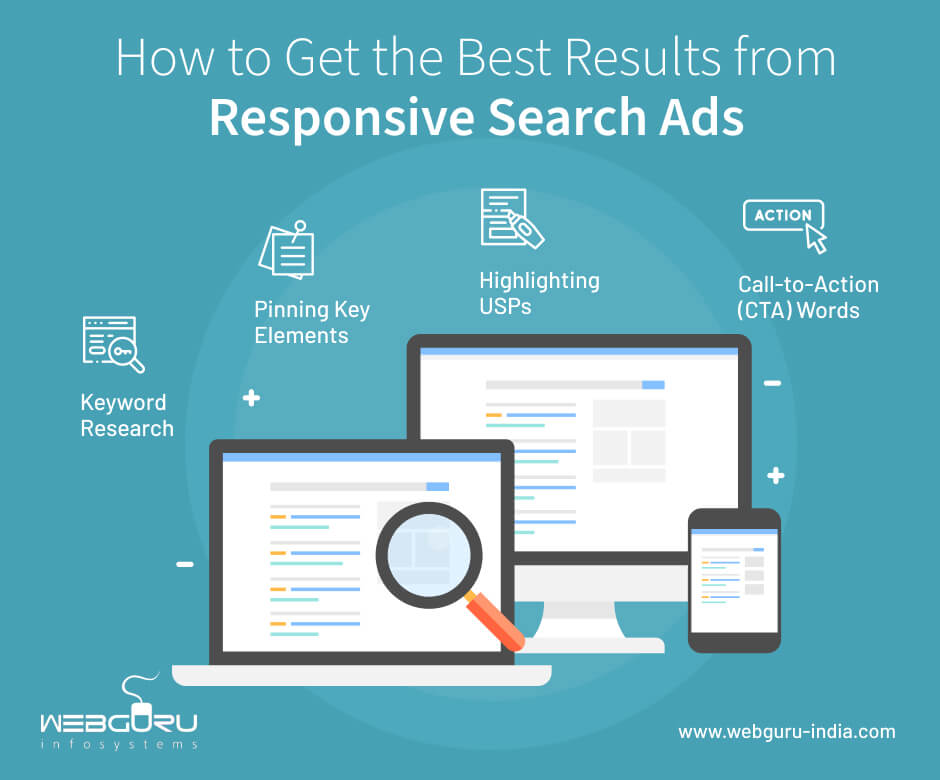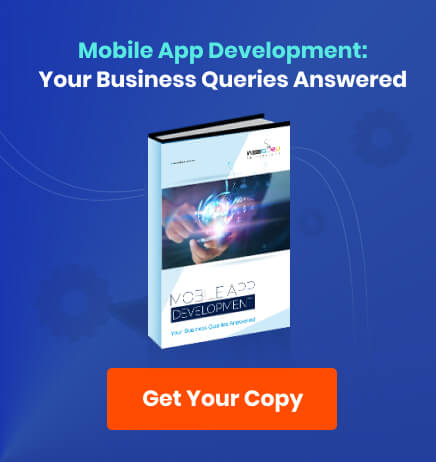Home Blog Digital Marketing Services How to Get the Best Results from Responsive Search Ads
How to Get the Best Results from Responsive Search Ads
- 19 Oct / 2022
- 2,356 views
- 5 Min Read

Responsive Search Ads (RSA) are the latest, flexible search ad format from Google. The goal of responsive ads is to reduce human intervention and effort, instead pushing more for automation. This also potentially opens up new business avenues for advertisers, since ads can now show up for more varied search queries that you may not have originally thought of. Also, leveraging automation for your ads can leave you open to further business development activities. In fact, PPC Management Services worldwide have started to prefer shifting towards automated advertising
RSAs are a significant change from expanded text ads (ETA), the creation or modification of which was stopped by Google on June 30th. So PPC management services worldwide have had the challenge of running search ad campaigns only through the automation-based RSAs. Google claims that RSAs can get you 4 times more impressions than Expanded Text Ads. Of course, not all impressions lead to conversions, so your conversion rate might see a dip. However, the overall number of conversions is likely to increase significantly. Your ultimate aim is to get maximum clicks and conversions at a low cost.
How to Get The Best Results out of RSAs
For RSAs, Google gives you the option to enter up to 15 headlines and 4 descriptions, which is a significant upgrade from ETAs. The Google algorithm analyzes these inputs and comes up with combinations that it feels will generate the best results. It optimizes your ads based on what headlines and descriptions generate how many impressions and clicks. However, there is a learning period involved for RSAs to get you the best results. In the meantime, Google might come up with title-description combinations that either misrepresent your services or make no sense. It is very important to write your ads smartly so you can keep your ad relevance and CTR up not only during this period, but also after. Here’s how you make the most out of RSAs.
1. Keyword Research
Carefully research your keywords to include popular search terms. Find out what people are actively looking for. Google keyword research tool is great for insights like how often certain terms are searched, and how they have evolved over time. Additionally, popular forums such as Reddit, Quora, and other discussion boards can be very helpful in understanding people’s queries and interests.
2. Concise, Distinctive, and Memorable Headlines
Include key details in your headlines such as brand name, benefits, call-to-action, and so on. Create distinct variations of these, combining the elements in multiple ways. Try to keep them concise and memorable, with each headline offering fresh information or a unique take.
3. Headlines Containing Popular Keywords
Include popular, trending search terms within your headlines. It not only significantly increases the visibility of the ad, but also the chances of people clicking on it. Google’s keyword insertion tool and search term report can be very helpful in this regard. Use them to pick out at least 3 popular search terms for your headlines that are likely to catch people’s attention.
4. Call-to-Action (CTA) Words
Phrases like “book now” and “contact us today” can significantly motivate people to click on your ads. Make sure you choose your CTAs based on what kind of action(s) you want them to take once they click on your ad. It should lead them to buy your product or service, or reflect their buyer journey after they click.
5. Highlighting USPs
Make sure you are highlighting your product’s unique selling points and key value propositions in the description, if not the headline itself. Of course, enticing hooks with offers and discounts capture people’s attention too, but your USPs will allow viewers to make an informed decision when purchasing.
6. Pinning Key Elements
Google gives you the option to pin certain headlines and descriptions if you wish to. If you’re unsure about the combinations that Google might come up with, use this feature to optimize your ads as best as you can. You can ensure that key elements such as product names, prices, USPs, etc. get priority and always show up. This will also help you keep track of and assess individual elements to see which performs better, so you can make changes accordingly.
7. Leveraging Extensions
Google Ad extensions will let you push more information through your ad with no additional charges. You should try to leverage them to provide as much information to your customers as possible through your search ads. Additional links in your ad also have the potential to improve the click-through-rate (CTR) as well.
- Image – You can upload an image to appear beside your search ad, which can certainly attract viewer attention.
- Sitelink – This is a very common and effective extension that can be used to provide additional clickable links to various pages within your website under your search ad. It can effectively be used to advertise multiple pages at once.
- Callout – This extension lets you add a short (up to 25 chars) blurb of text beside your search ad, and can be used to “call out” some of your USPs.
- Structured Snippet – This is similar to callout extensions, and can be used to provide a quick list of your services or offerings.
- Call – Call extensions are used to attach a phone number next to your ad. It can be effective to drive calls to your business since customers won’t have to open the landing page for your contact information.
Assessing Your RSA Performance
True, there’s still a certain level of guesswork involved when trying to understand RSA performance. You are still not shown the individual performances of your headlines and descriptions, nor are you shown which ads show for which search terms. However, there’s plenty of data that Google does show, and they can be leveraged for structuring your RSA campaigns to the best effect.
- Google provides feedback on the quality of your ads through the Ad Strength metric. While you don’t necessarily need to make all the changes that Google suggests, you shouldn’t dismiss it either.
- Since you have the space for 15 headlines and 4 descriptions, make your choices smartly. Understand that more elements mean more guesswork on your part. Conduct the experiments mentioned above to understand what works best.
- Your conversion results don’t depend on your RSAs alone. In fact, it largely depends on your customer’s experience on your website, especially the landing page. Make sure you have a well-designed website that is easy to navigate, has clearly visible CTAs, and is overall optimized for a great user experience.
Additionally, here are 2 tests you should conduct with Responsive Search Ads. These will give you a reasonably good idea about what might work for you. These should effectively reduce the guesswork involved, and make it easier to create successful RSA campaigns.
1. Fully-Automated vs Semi-Automated
First, you should see what effects pinning certain headlines or descriptions have on your ad campaign, as compared to allowing Google to dynamically select them from your provided list. By default, Google will mix and match from within your provided headline and description, while the AI learns what combinations work best and generate the most responses and conversions. If you pin certain inputs, you’re fixing their positions, limiting any creative inputs from Google.
Create 2 identical responsive search ad sets, filling in as many of the 15 headlines and 4 descriptions as you like. Ideally, try to fill in all, and make sure they are identical in both of your RSAs. Then pin some of the headlines and descriptions in one ad, while leaving the other one as it is.
The idea is to find out whether Google’s fully-automated advertising works better for you than your controlled semi-automated process. Sometimes advertisers really need control over their ads, especially if Google starts creating combinations that make no sense. Measure which set gives you better impressions, clicks, conversions, conversions costs, and so on. It gives you a good idea of how big a gap Google creates between the two sets, and it also helps gain insights for further A/B testing.
2. Splitting Ads by Message
Now that Google and other ad platforms are swiftly moving towards automation in managing advertising campaigns, your messaging has never been more important. This is very important and will form a significant part of your RSA testing.
Google allows a maximum of 3 responsive search ads per ad group. So max out on this feature for this experiment. Create multiple ad groups, each focusing on a different kind of message and set of keywords. Use broad matches, and address different buyer personas, topics, offers, and pain points. Create variety as far as you can within each ad group as well. Cluster one service within one ad group, while keeping separate ads for separate services within another. The more variety you can create within your messaging, the better.
Through this experiment, you might be able to learn what kind of messaging works best for your ideal clients, what shows the best responses, and what kind of queries they are generating impressions for. You will have a good idea of what your customers want to hear from you and what precisely they are looking for.
Conclusion
Making the best out of Google’s new automation facilities will require a new approach to advertising. The old techniques don’t necessarily work anymore. Optimize your ads and their structures & information as best as you can – and with a certain level of patience, you too can reap the rewards of RSAs.

Priyanka Agarwal
An expert digital marketer with vast knowledge in SEO, SMO, and the like, Priyanka Agarwal writes about the latest trends in digital marketing.
4 comments
Leave a Reply

-
1000+
Happy
Clients -
25+
Countries
Served -
19+
Years of
Trust








Responsive search ads are a new type of ad format that allows advertisers to create ads that are responsive to the user’s search query. This means that the ad will be able to dynamically change its copy and appearance based on the user’s search query, in order to better match the user’s intent. The goal of responsive search ads is to improve click-through rates (CTRs) by providing more relevant and targeted ads to users.
A great read! Insightful, informative and definitely helpful.
Very well written blog with lots of usable information! Thank you..
Responsive search ads are the best thing to happen for digital marketers to embed automation in their marketing effort. The blog nicely explained how the new approach to advertising can reap rich rewards for businesses.